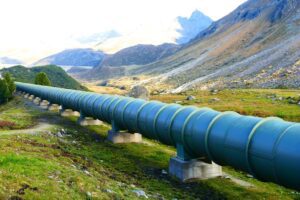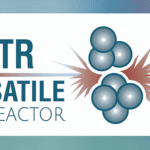The Department of Energy (DOE) officially launched development of its Versatile Test Reactor (VTR), a fast reactor that will foster experiments with much higher neutron energy and flux compared to the nation’s existing 35 research reactors to develop advanced nuclear fuel for future nuclear power plants in the U.S. The facility, it says, is necessary to keep the nation technologically competitive with China and Russia.
The agency on Aug. 5 published a Notice of Intent in the Federal Register announcing it would develop an environmental impact statement (EIS) to study impacts of building the novel experimental reactor. The DOE will accept public comment on what the draft EIS should include until Sept. 4, and it plans to issue a draft EIS analysis within “the next several months” for public comment.
On Monday, the DOE also announced that it is considering two locations for the VTR: Idaho National Laboratory (INL) in eastern Idaho, and Oak Ridge National Laboratory in eastern Tennessee. Two sites, INL and the Savannah River site in South Carolina, are also under consideration for the fabrication of the fuel needed to run the VTR.
Fast-Tracking a Fast Reactor
The announcements indicate the DOE is accelerating the VTR program. The agency conceived the program in February 2017, but it only established a mission need earlier this year. As a program document from January 2019 shows, the mission of the program is: “To provide leading edge capability for accelerated testing and qualification of advanced fuels and materials enabling the U.S. to regain and sustain technology leadership in the area of advanced reactor systems.”
The DOE suggests the facility could start up by 2026. It will likely be a sodium-cooled pool type reactor that will use fuels with metallic alloys, including high-assay low-enriched uranium (HALEU) fuel. The DOE estimates the VTR could cost $3 billion to $6 billion, based on similar projects.
In November 2018, Battelle Energy Alliance (BEA), a government-owned contractor that manages the DOE’s national laboratories, announced it had selected GE Hitachi Nuclear Energy’s (GEH’s) PRISM technology to support the VTR program. The selection means GEH and engineering, construction, and project management giant Bechtel will “advance the design and cost estimates for the VTR based on GEH’s PRISM technology,” which is the only sodium-cooled reactor to have successfully completed the U.S. Nuclear Regulatory Commission pre-application review process, GEH said.
However, the DOE also has subcontracts with several universities, and it plans to engage several industry stakeholders, such as Framatome, Westinghouse, TerraPower, General Atomics, and the Electric Power Research Institute, in the project. The DOE is also seeking to cement an assortment of international collaborations, including with South Korea, France, and Japan.
DOE: VTR Needed for Industrial Interest and National Security
The DOE pegs the need for the experimental fast reactor to industrial interest in fuels, materials, and instrumentation and sensors testing for several advanced nuclear reactor concepts, including sodium-cooled reactors, lead-cooled reactors, gas-cooled reactors, and molten salt reactors. Concepts for some of these reactors “may be ready for a demonstration unit within 10 years,” and their domestic deployment will be critical to sustain nuclear power’s role in the clean energy transition, it says. The VTR will be integral to developing continuous improvements in operations and economics beyond the demonstration phase, it claims.
According to the Nuclear Energy Institute, an industry trade group, test capabilities offered by the project could be helpful in the demonstration of advanced reactor designs. HALEU, for example, is needed for a handful of microreactors under development—many smaller than 10 MW—but also high temperature gas reactors that may be operating in the 100-MW to 200-MW range and salt reactors, it said. A January 2017 report issued by the DOE’s Nuclear Energy Advisory Committee, meanwhile, notes that all nuclear vendors interviewed indicated they would utilize irradiation services that a fast-spectrum reactor can provide with rapid accumulation of displacements per atom under prototypical conditions. The tests could help “qualification of fuel, qualification of fuel manufacturing processes, extension of the useful lifetime of cladding and structural materials under irradiation, study of corrosion behavior of materials and advanced coatings under irradiation, and demonstration of fuel performance,” it says.
However, the DOE also cites national security and scientific interests as reasons for why the schedule to build the VTR is accelerated.
As POWER reported in March, fast neutron reactor systems have the potential to extract 60 times more energy from uranium compared to existing thermal reactors, and they contribute to a significant reduction in the burden of radioactive waste. But while wide progress has been made of late in many countries that are actively developing the reactors and related fuel-cycle technologies, the U.S. has no fast spectrum irradiation capability to support the advanced reactor research. U.S. researchers have to date depended on access to the Bor-60 reactor in Russia, but they face multiple barriers when seeking access to Russian reactors, “including export control concerns for materials and fuels testing, intellectual property rights, and international transportation issues,” the DOE said.
In a statement on Aug. 5, U.S. Assistant Secretary for Nuclear Energy Rita Baranwal said the DOE was acting to develop the fast reactor on an “accelerated schedule to avoid further delay in the United States’ ability to develop and deploy advanced nuclear energy technologies.” She added: “If this capability is not available to U.S. innovators as soon as possible, the ongoing shift of nuclear technology dominance to other international states such as China and the Russian Federation will accelerate, to the detriment of the U.S. nuclear industrial sector.”
On Monday, Energy Secretary Rick Perry agreed. “Lack of a domestic reactor with versatile fast-neutron-spectrum testing capability is a significant national strategic risk affecting the ability of DOE to fulfill its mission to advance the energy, environmental, and nuclear security of the United States and promote scientific and technological innovation,” he said.
—Sonal Patel is a POWER senior associate editor (@sonalcpatel, @POWERmagazine)










